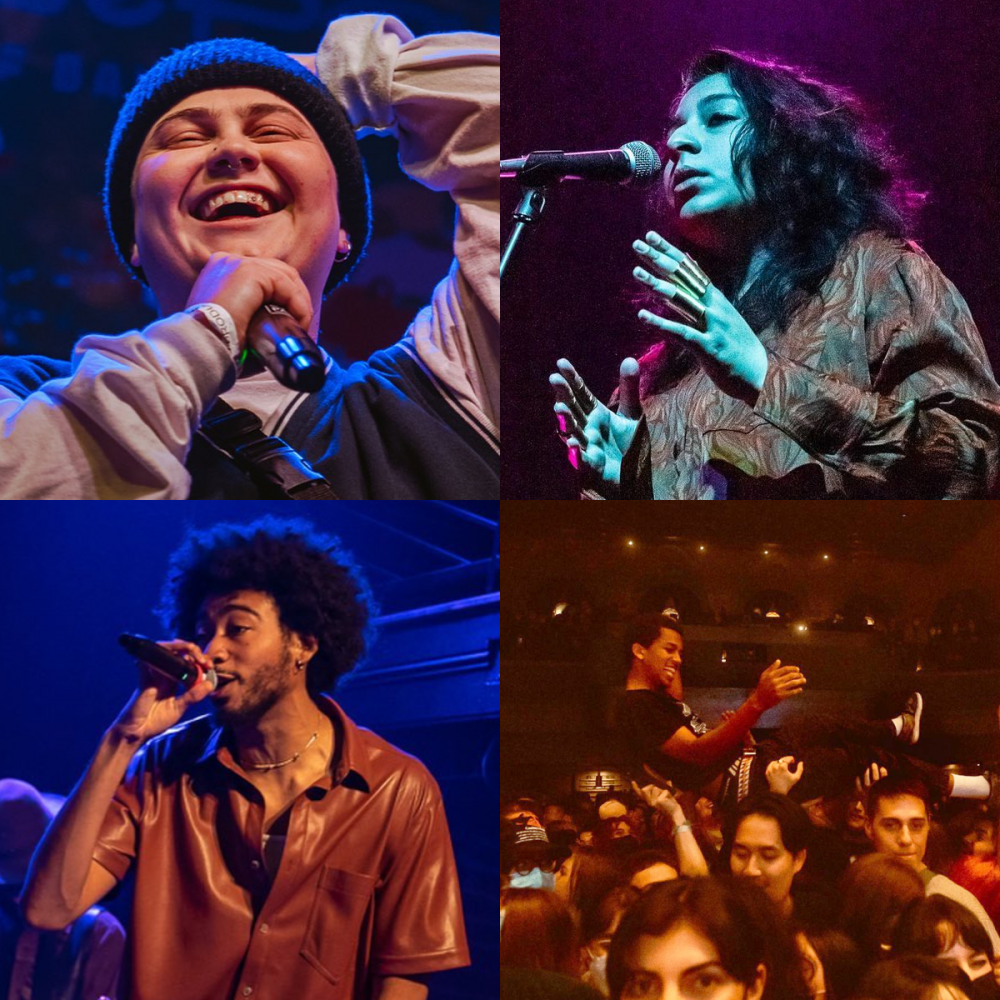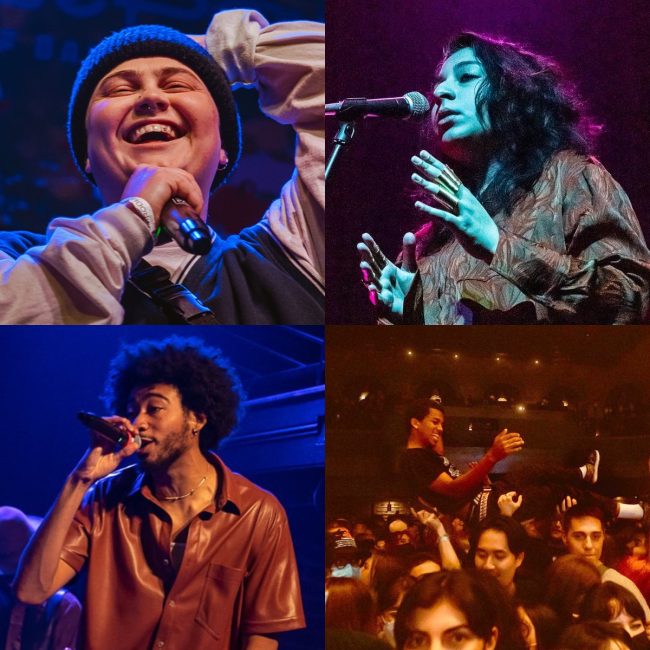
Support real, independent music journalism by subscribing to Passion of the Weiss on Patreon.
This winter has been particularly cold for live music fans. While the past fall gave the vaccinated a surreal step towards our prior concert culture for the first time in over a year, the Omicron surge that began in December pushed the industry back to an ominous half-state. Throughout January, several artists canceled performances less than a week out due to members of their touring party getting sick, or because they lost confidence their tour could proceed safely. Other bands simultaneously announced lengthy show dockets just weeks away, sometimes without acknowledging the irony of the moment, other times using a tone that seemed to recognize “this is as just as likely to happen as not, but fuck it ¯/_(ツ)_/¯”.
As Lucy Dacus quipped, “the show actually does not have to go on”. However, both musicians and listeners sincerely hope it can reasonably resume sooner than later. The current surge has largely crested, so much so that the biggest festival in the country felt confident enough to drop (not uncontroversially) all their COVID precautions. Thus ticket holders are once again faced with the prospect of reviving hope, one that could easily lead them to fall right back on their faces.
Within this tenuous moment, San Francisco’s annual Noise Pop festival took place last week, something of the first wider scale live music event in the city. Artists both local and national and covering all styles of music performed across the city under a single banner, one you could buy an all-access badge to navigate however you like. I decided to use the opportunity as a launching point for my own tepid return to concert venues, and as a reflection point to more broadly check in on how live music feels in this transitory moment.
While I’ve attended as I’ve felt comfortable a good handful of shows since last August, Noise Pop was my first time bringing live music back in as a consistent presence in my life. Spending every night of a week attending the various shows taking place across the city was a whiplash feeling of going from 0 to 90. But in many ways it was also a return to routine. Of course, when you’ve been robbed of that routine for nearly two years, the ritual takes on a profound emotional shape. I share my observations and reflections from the experience below. – Pranav Trewn
View this post on Instagram
Show #1: Kamaal Williams at the California Academy of Sciences
I am blessed to live a block and a half from Golden Gate Park, where dozens of trails, bodies of water, and secret gardens kept my “pandemic walks” novel for ages. But as ages passed, those walks began to feel as tedious a part of my mental health hygiene as brushing my teeth. If anything, these strolls made me confront head on how the city was changing, the silence and scarcity that defined the neighborhood during the plague’s worst months.
So the first thing I noticed when returning to the California Academy of Sciences for the Noise Pop “pre-party”, my first time back inside the park’s central museum since 2019, was the familiar sensation of activity in a building that’s largely sat dormant the last two dozen months. I was eager to take it all back in, so my friends and I wandered through the Osher Rainforest, receiving a demonstration on structural coloration, then made our way through the Steinhart Aquarium and took several photos of sea nettle jellyfish. By the time we reached the West Garden for Kamaal Williams’ expectedly rollicking performance, I had forgotten I was only some 3000 feet from my apartment. The setting seemed a world away, in both space and time.
The event was honestly better than how I recalled concerts prior to the pandemic, the multi-purpose use of the facility reminding me of the ways music can fill in the cracks of a city and lift it to life. The last time I saw Kamaal was at this very festival in 2019, back when I had only just started living in San Francisco proper. Coming back to watch his performance this year – held down by a quartet of drums, guitar, saxophone, and the man’s impeccable keys – was the most remarkable sensation of deja vu. How much time has passed, and how little difference it made to how good all of this still feels.
Show #2: Arooj Aftab at Gray Area
After Kamaal Williams the prior Thursday, Noise Pop officially began in full force on Tuesday. The first act in the weeklong marathon was also my own personal headliner for the whole thing, the Brooklyn Pakistani songwriter Arooj Aftab, who’s breakout last year Vulture Prince reimagined the ghazal tradition of longing poetry with threads of contemporary folk, jazz, and devotional Sufi music. I met up with a fellow South Asian friend equally proud of seeing heritage-drawn music reach such levels of critical acclaim and cultural recognition (the album is currently nominated for two Grammys, as Aftab made light fun of during the show). We got drinks at the nearby Horsies Saloon, where the vermouth and sherry cocktails, fondly kitschy and cramped decor, and patronage of regulars (shouts out Tumbleweed, the cutest neighborhood pup) brought me back to all the ways concerts connect me to my city on a deeper level.
We subsequently made our way to the comparably sparse Grey Area, a venue where I’d only ever previously seen a podcast taping. The space lives up to its unadorned name, a suitably blank canvas for opener Ouri to cast her eclectic spells. She mixed things up every other song, sometimes layering swaths of oceanic synths and arpeggios not unlike Four Tet, other times pulling out some R&B flows that gave me Kelela vibes (side note: where did Kelela go??). Then came Arooj, flanked on her right and left by a harp and acoustic guitar, instrumentalists who deftly fleshed out the sound of a full ensemble as they rolled through the majority of Vulture Prince.
The set was immersive, the room stunned into silence and then roaring with applause between songs. The production for the headliner remained barebones, just six monochromatic lights blurring the stage in a single shade. But if it obscured visibility, it let the music speak for itself that much louder. One of my fears returning to live music post-pandemic was that touring would be in the short term a predominately mainstream affair, what with indie venues closing and bands unable to sustain the capital to support tenuous itineraries. I don’t know how many t-shirts I purchased over the first year of Covid to support artists unable to make money from other ventures, doing my small part to keep them afloat long enough to make it back onto the road. How meaningful it was to finally offer my support now with a concert ticket, having the opportunity to buy a shirt in tandem with a memory I actually hope to revisit.
Show #3: The Microphones at Swedish American Music Hall
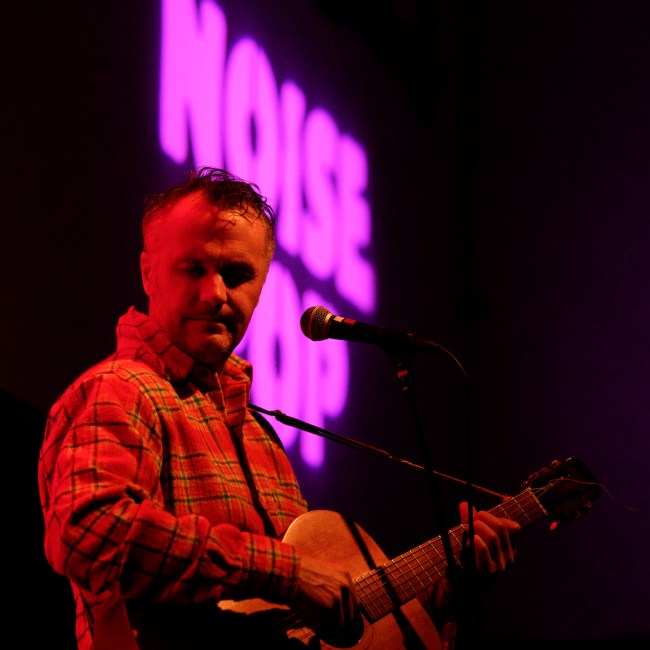
Photo via Jon Bauer
The music journalist existence is often a solitary one, particularly for those who have social lives not completely defined by their musical interests. When it came to the Noise Pop lineup, I was fighting an uphill battle to convince any of my friends to join me in seeing the names I was most excited for, none more so than the Microphones. “Want to watch a middle-aged recent widow and divorcee talk-sing morbid and existential details from his life?” Not an ideal Wednesday for most. I got a flashback to my first week moving to DC, when I rallied my new housemates to catch Phil Elivirum perform at a church his harrowing songs about the death of his first wife. I hadn’t given them sufficient context for what to expect, and the looks they shot me all night between tears communicated something along the lines of, “Why the hell would you put me through this?”
Suffice to say, I didn’t even bother trying to bring along a +1 to the Microphones. That decision was immediately validated when I walked into the venue moments before the opener Ragana began wailing out their wall of epic but incredibly harsh sound. I watched folks ill-prepared without ear plugs dash out of the main room in shock, which gave me at least a little extra respect for Elivirum for pairing his acoustic indie rock with this. That antagonistic regard only increased when it dawned on folks that not only was he opening with his 45 minute, two-chord experimental epic “Microphones in 2020”, but that that was all he was playing. The crowd’s applause after he finished quickly took on the tone of a plea, bargaining for more before the lights came on unceremoniously. I was impressed by his willingness to strike a stake into his paying fan base, separating the wheat from those hoping to hear literally anything from The Glow Pt. 2 (which I mean is definitely a reasonable position).
As for myself, I was mesmerized by the autobiographical showcase, which in my mind is a feat of performance more impressive than a 90 minute run of singles. Not simply the commitment to the bit, but the endurance it takes to excavate personal moments from your life to an audience who is almost certainly hanging on by rapidly diminishing goodwill. This Microphones tour was never intended as a feel good reunion. Elverum sang as much himself. “Microphones in 2020” refers to the band as an “imagined collective”, and lambasts groups reuniting for money glorifying their past. This “effort” – as he referred to the song – “never ends”, a moment when the crowd responded with laughter. Later on he called nostalgia embarrassing, at least a partial own to everyone who paid money to see a band who hadn’t released an actual record in 19 years. It’s a profound anti-statement about looking for meaning where there is none, and finding it anyway even though you’ve lived long enough to know better. That I walked away feeling moved is surely a result that would disappoint Elverum.
Show #4: Alice Phoebe Lou at The Chapel
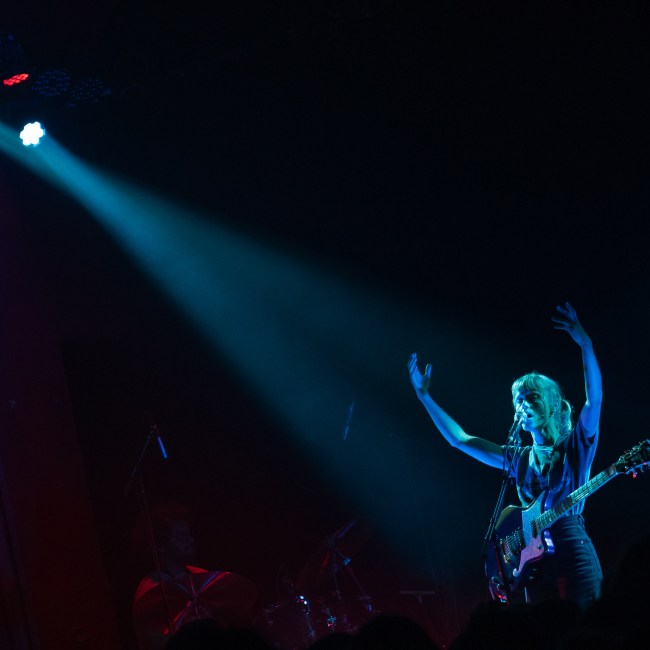
Photo via Norm de Veyra
Part of the Noise Pop experience was unfortunately, but not unexpectedly, dealing with cancellations. Weeks ago the lineup lost some of its heavy hitters, including MIKE, Guapdad 4000, and Titus Andronicos. Then in the days leading up to the festival, my planned Saturday night to see the rising jazz star Connie Han was scrapped. The lineup remained strong in spite of these cuts, but it did leave me feeling like I was choosing between what was left, rather than the more ideal festival scenario of struggling to fit everyone into your schedule. Still, I didn’t fuss much given the last two years; having plans axed at the last second hardly registered disappointment anymore.
The best concerts are rarely those you meticulously anticipate anyway, but rather the ones that you might never have attended if not by dumb luck. Alice Phoebe Lou was the best of that sensation I felt during the festival. She seemed the most exciting proposition for the evening based on a few scanned singles, a bit Molly Burch by way of Maggie Rogers. As for my other options, I’m well past my Alex G phase, though I was nearly swayed by the chance to see Bill & Ted’s Excellent Adventure with opening sets from local bands Thunder Boys and Shut Up.
When I got to the Mission, it felt like I had chosen the hottest ticket in town – the line to get in stretched well out the door. The density flared up my lingering Covid anxiety for the first time during the festival, something that wasn’t helped by seeing a couple folks taking rapid tests right outside before getting in line. But a New York Times breaking news notification earlier in the day about relaxing CDC guidelines sustained my confirmation bias about this being a good decision. I got in place and waited to see what the hype was for myself.
Despite standing out by several shades within the crowd, I caught the same bug that had seemingly infected the rest (which at this point I was still hoping wasn’t Covid). Alice Phoebe Lou’s music proved delightful, all ringing jangles and sunny melodies locked in by gliding percussion. I started out on the balcony, but eventually felt the urge to bounce with the rest of the bodies below. That impulsive decision felt revelatory, that I even had the option for spontaneity after dozens of months of living in a purgatory dictated by the rhythms of my laptop and ingrained public health heuristics. I’m publishing this piece symptom free, so let’s take it as a good omen that we might be back to a place where choosing to do the things that feel good can actually feel good.
Show #5: Tomberlin at The Chapel
I am frustrated a bit by how heavy my show selection to this point had leaned toward singer-songwriters. This was due to a combination of most of the hip-hop acts being canceled, and the best of the jazz and rock artists all playing shows in the East Bay, where I would have normally made the trek but was at a loss for time during an overwhelming work week. By Friday I felt ready to branch out with Makaya McCraven at Oakland’s The New Parish, until my partner – slightly resentful of my being out every night of the week – said she’d join me for the Tomberlin show back at the Chapel. Beyond simply being a fan myself, I hold dearly time with this medical student who rarely has free evenings. The choice was easy.
We got drinks outdoors at Curio, a bar literally attached to the Chapel, before making our way inside. Boy Scouts’ Taylor Vick performed a solo set of gentle hushers, which appropriately set the austere tone Tomberlin carried through. She teased new cuts from what I expect will be a profile-rising sophomore album, but also played some fan requests on the spot. The rapturous reaction of the crowd was reciprocated by Tomberlin, who stopped singing momentarily to note her appreciation for having others sing along to songs she wrote in her bedroom. “I’m so jazzed to be here,” she beamed, noting this was one of her first shows back. How surreal it all felt to her made it feel all the more surreal to me. Towards the end she invited headliner Hand Habits on stage to perform her latest single “Happy Accident”, a song they learned earlier that day, and the ramshackle jam was loose and familial. “Wow, music is so fun,” Tomberlin exclaimed at the end before walking off the stage. A fitting coda to a set by an artist who often makes simple emotions hit with a profound grace.
Show #6: John Carroll Kirby at Swedish American Hall
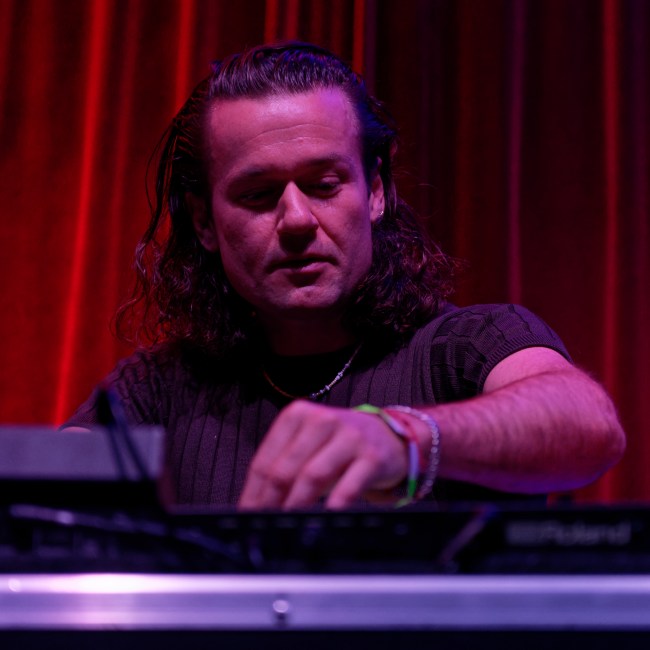
Photo via Jon Bauer
I had waffled throughout the day on whether I’d even make it out again by Saturday evening; four weekdays of concerts in a row begins to make you panic about tending to other avenues of your life. I definitely had some work to catch up on, friends to catch up with, and probably at least several hours of other media I’d neglected for live music. But it was ultimately inconceivable I’d miss John Carroll Kirby. The dude is a Stones Throw multi-instrumentalist with credits on the likes of Solange’s twin masterpieces, The Avalanches’ We Will Always Love You, and Blood Orange’s Freetown Sound. His solo albums are all wildly accomplished, demonstrating the types of technical chops that I’d lacked in previous nights of largely stripped down songwriters.
To my initial disappointment, the show was a solo affair, letting down my hopes for a full band recreating the electric splendor of his recent record Septet. But Kirby bolstered his sound by mixing in live synths and percussion while he performed on the grand piano, now and again switching to a set of pads. Rather than bowl us over with technical showmanship, his touch remained subtle, suggestive of directions he could move without feeling the need to fully spell them out. That was consistent with his often understated presence on others’ records, but it did make for a slightly sleepy experience, and the crowd both thinned and grew chattier as the show progressed.
But for those left listening closely, it was tough not to get lost in Kirby’s own enthrall. His mannerisms of performance were exaggerated but sincere, like the whole set was a (successful) attempt to impress himself. The grace it takes to remain inspired while playing to a nearly empty room felt even more profound after Kirby revealed it was his birthday. Not once betraying a sense of disappointment, he led a sing-along of “Happy Birthday”, and then got an audience member to pass out Prosecco and plastic cups throughout the crowd. Elsewhere in the evening he had us shout out animal sounds to accompany a song inspired by an Amazonian myth, and did crowd work not unlike an amatuer stand-up. Every occasion to perform is an opportunity to celebrate, I thought with a corny but genuine sentimentality. Doing my best elephant honk, I had forgotten I had ever questioned making it out in the first place.
Show #7: Azealia Banks at The Warfield
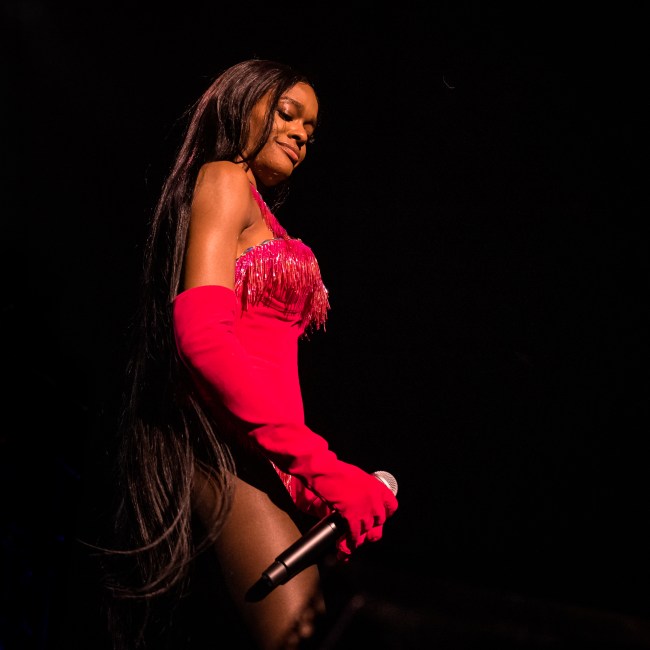
Photo via Paige K. Parsons
Headliner. That’s the word that kept swimming in my head on the MUNI en route to Powell, where I’d be seeing cultural provocateur, Grimes’ mortal enemy, and sometimes-musician Azealia Banks. The one-time heir apparent to New York’s art-rap throne, Banks is hardly a contemporary hitmaker anymore, and while objectively the most widely known entity on the Noise Pop lineup, she is by no means the most beloved. An informal poll of friends suggested that few could name a song of hers that dates past 2014. I myself couldn’t be bothered to keep up with her latest scandals, nor even fully remember her classic ones (if going to this concert was actually a cancellable offense, I plead ignorance). But “212” still goes, and “Fuck Him All Night” was a better single than I was expecting from Azaelia in the 2020s. I didn’t have high hopes, but I definitely had curiosity for what this performance would look like, the type of curiosity I’d be an irresponsible journalist not to chase.
While her stage presence was stilted and her dancing awkward, my main conclusion from the show is that Azaelia can still flow and belt circles ahead of her disciples. Her performance was a reminder that if not for the label drama, Azaelia had a real shot at mainstream pop stardom. Several of her newer songs landed as the biggest of the night, and overlapped significantly with commercial trends, from the Travis Barker-rumble of “Wings of a Butterfly” to the Latin pop of “Salchichon”.
Not unlike Tinashe, the messiness of her career trajectory obscures the fact that her catalog is far more interesting than she gets credit for. “Liquorice” had the crowd erupting to the ceiling. “The Big Big Beat” felt appropriately massive. And “212”? “212” was the most glorious moment of the whole festival. It struck me that I have incomplete relationships with many of the songs I’ve come to love over the last few years because I haven’t had a chance yet to share them with a room of strangers. I can officially cross “212” off that list, something I didn’t realize I needed but can thank Noise Pop for having the vision to deliver.
After the way the pandemic decimated the live music industry, it was easy to imagine that adventurous independent promoters like Noise Pop might not have withstood the shifting landscape. That they have weathered the storm, continue to manuever the aftershocks, and are still putting together programming of this quality and significance to the city? That’s the best indication that maybe we’ll make it out of all of this alright after all. Whether or not the show has to go on, it’s nice to know it still can.

